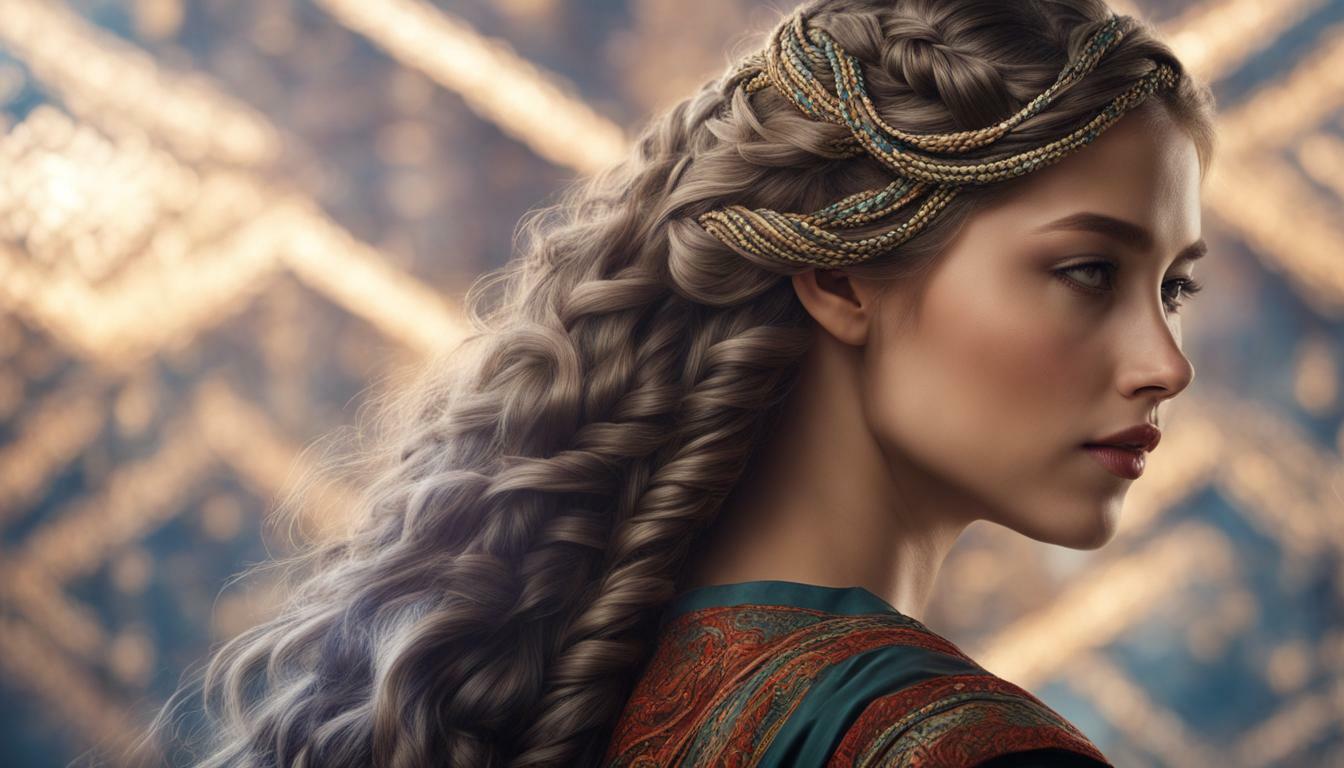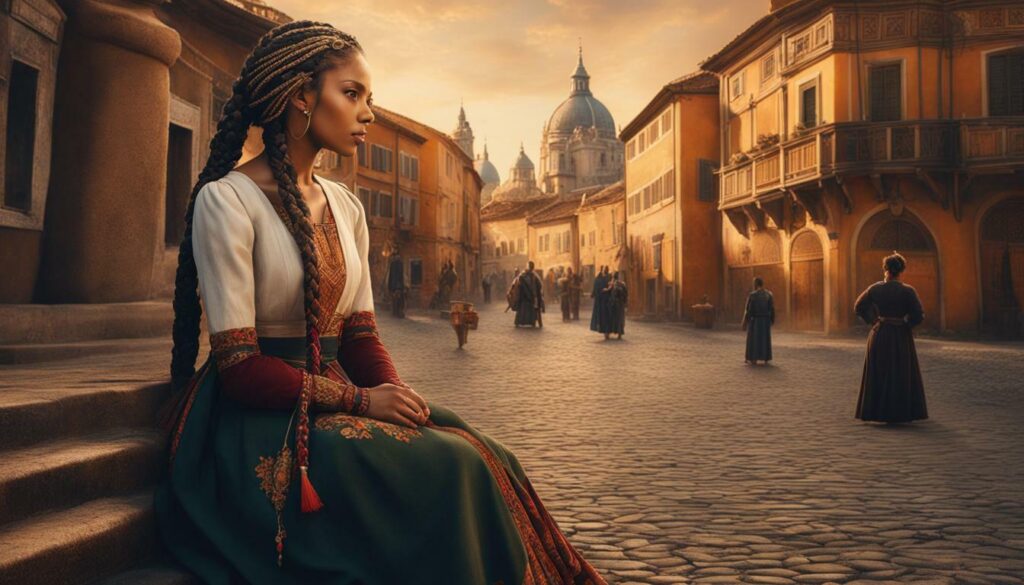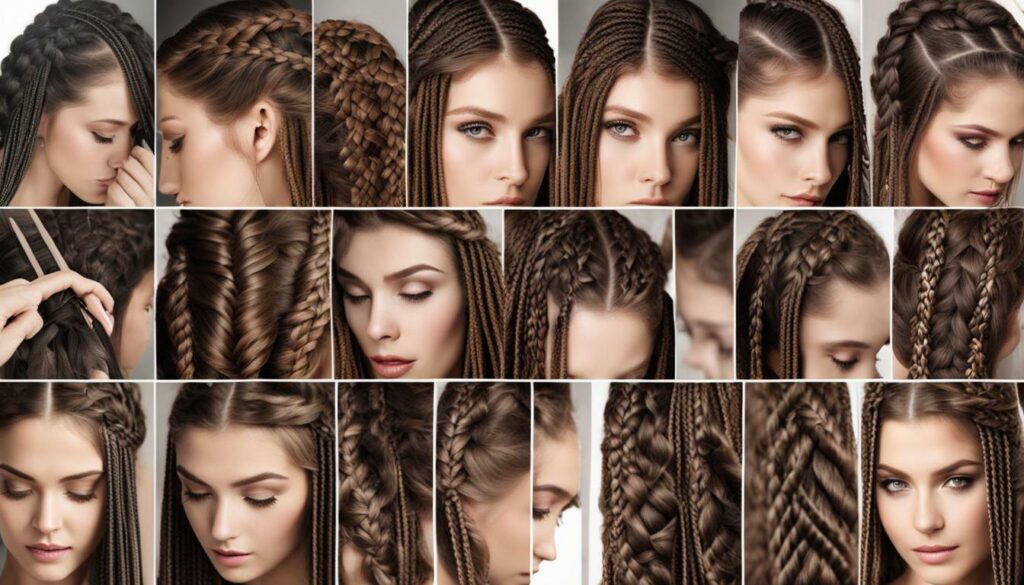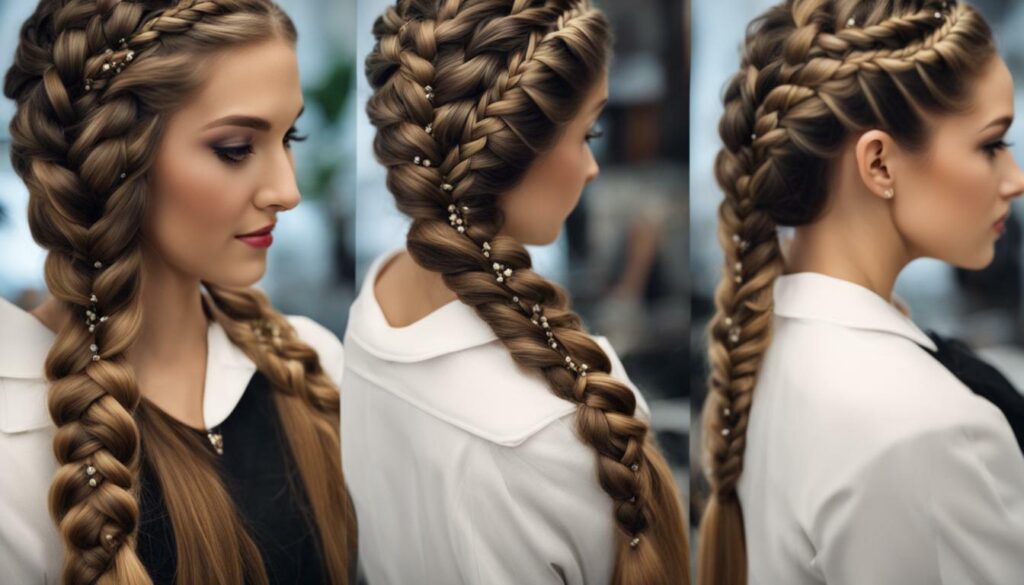
European braids have a rich history and are an integral part of traditional European hairstyles, with a long-standing tradition of intricate braiding techniques. They have been a cultural staple for centuries, originating from African cultures and later adopted by Greek traders who introduced braiding styles to Europe. Initially, European women were fascinated by box braids, which were brought from Egypt by Greek traders. Over time, European cultures developed and embraced their own unique braiding styles, such as Dutch braids and French braids.
Key Takeaways
- European braids have a diverse history and cultural significance, initially influenced by African cultures and later adapted by European civilizations.
- Box braids, Dutch braids, and French braids are popular and distinctive types of European braids.
- Braided hairstyles have been used by various European cultures to symbolize cultural identity, status, and modesty throughout history.
- European braids are distinct from African braids in terms of thickness, weaving techniques, and cultural meanings attached to them.
- Anyone can wear European braids, regardless of cultural background, as they are not exclusive to a particular culture.
History and Cultural Significance of European Braids
Braids have been worn by various European cultures throughout history, including the Romans, Greeks, Celts, and Vikings, and have played a significant role in their cultural identity and self-expression. European braiding techniques were initially adopted from African cultures when Greek traders introduced braiding styles to Europe after trading with Egyptians, who sold them box braids.
One of the most popular braiding styles among European women is box braids, characterized by its neat and uniform appearance. However, European cultures also developed and embraced new styles such as Dutch braids and French braids. These braiding techniques feature intricate weaving patterns that create stunning and elegant hairstyles.
Braided hairstyles in European cultures held various meanings. They were often used to symbolize cultural identity, status, and modesty. For example, in ancient Rome, elaborate braided hairstyles were worn by women of high social status, while simpler braids were more common among lower classes. In Celtic culture, braided hair signified strength and power, with warriors often sporting intricate braided hairstyles. Vikings, known for their adventurous spirit, favored braided hairstyles as a way to keep their hair secure during their explorations.
European braids are distinct from African braids in terms of their thickness, the way they are woven, and the cultural meanings attached to them. However, it’s important to note that anyone can braid European braids, as they are not exclusive to a particular culture. Braiding has been a significant part of European history and continues to be a popular hairstyle choice today, transcending cultural boundaries and becoming a timeless fashion statement.

| European Cultures | Braided Hairstyles |
|---|---|
| Romans | Elaborate braids for high social status |
| Greeks | Adopted braiding styles from Egyptians |
| Celts | Braided hair as a symbol of strength and power |
| Vikings | Braids for secure hair during explorations |
Different Types of European Braids
European braids come in various styles and techniques, with popular choices including Dutch braids and French braids, known for their intricate weaving patterns and timeless appeal. Dutch braids, also known as inverted braids or inside-out braids, are created by crossing strands of hair under one another, resulting in a raised braid that sits above the scalp. This style offers a neat and polished look, perfect for both casual and formal occasions. French braids, on the other hand, are characterized by their close-to-the-scalp braiding technique, with strands of hair being added to the braid as it progresses. French braids are versatile and can be worn in different variations, such as side braids or crown braids, allowing for endless styling options.
Another popular European braid style is the fishtail braid. This braid is created by dividing the hair into two sections and taking small sections of hair from each side, crossing them over each other to create a woven appearance reminiscent of a fishtail. Fishtail braids give off a bohemian vibe and are often adorned with accessories like ribbons or flowers for a romantic touch.
European braids are not limited to classic styles only. Modern variations such as the mermaid braid and waterfall braid have gained popularity in recent years. The mermaid braid involves creating multiple braids or sections of braids that are then woven together to create a cascading effect, resembling the flowing locks of a mythical mermaid. The waterfall braid, on the other hand, is created by dropping strands of hair as the braid progresses, creating a waterfall-like effect. These contemporary European braids offer a fresh and whimsical take on traditional braiding techniques.
Table: Comparison of Different European Braids
| Braid Style | Technique | Appearance |
|---|---|---|
| Dutch Braids | Crossing strands under one another | Raised braid above the scalp |
| French Braids | Adding strands of hair while braiding | Closely woven braid close to the scalp |
| Fishtail Braids | Crossing small sections of hair over each other | Woven appearance resembling a fishtail |
| Mermaid Braids | Multiple braids woven together | Cascading effect resembling flowing locks |
| Waterfall Braids | Dropping strands of hair as the braid progresses | Waterfall-like effect |
No matter the style, European braids offer a range of options for those looking to incorporate a touch of elegance and charm into their hairstyles. Whether you’re attending a special event or simply want to elevate your everyday look, European braids provide a versatile and stylish choice that has stood the test of time.

Mastering the art of European braids requires understanding different braiding techniques and following step-by-step instructions, allowing you to create stylish and classic hairstyles. Whether you want to sport a chic Dutch braid or an elegant French braid, here are some key techniques and tips to help you achieve the perfect European braided look.
- Prepare your hair: Before starting the braiding process, make sure your hair is clean and free of tangles. Brush through your locks to remove any knots and create a smooth foundation for the braid.
- Choose the right technique: European braids encompass a variety of styles, each with its unique braiding technique. Research and practice different techniques to find the one that suits your desired look. For example, Dutch braids involve cross-under sections, while French braids require crossing the strands over.
- Divide and conquer: Divide your hair into sections to make the braiding process more manageable. For longer hair, separate it into three equal sections, and for shorter hair, you can create smaller sections for a more intricate braid.
- Be patient and precise: Braiding is an art that requires patience and precision. Take your time with each section and ensure you are tightly weaving the strands together. This will ensure that your European braid stays intact throughout the day.
Remember, practice makes perfect when it comes to braiding. Don’t get discouraged if your first attempts don’t turn out exactly as you envisioned. With time and practice, you will become more adept at creating beautiful European braids.

Now that you have mastered the techniques, let your creativity flow and experiment with different European braiding styles. Whether you are attending a formal event or simply want to add some flair to your everyday look, European braids offer a versatile and timeless hairstyle option.
Table: Popular European Braid Styles
| Braid Style | Description |
|---|---|
| Dutch Braid | A tightly woven braid that sits on top of the hair, with each strand crossing under the others for a unique and fashionable look. |
| French Braid | A classic braid style where strands are crossed over each other, creating an elegant and intricate pattern. |
| Box Braids | A popular braiding style characterized by small, square-shaped sections, achieving a neat and uniform appearance. |
Experiment with these styles and make them your own. Whether you prefer a sleek and polished look or a more bohemian vibe, European braids can be adapted to suit your personal style. Remember to have fun and embrace the versatility of European braids as you create stunning hairstyles.
Conclusion
European braids have a rich history and cultural significance, symbolizing identity and style across various European cultures, while remaining a popular hairstyle choice today. These braided hairstyles, originally adopted from African cultures, have evolved over centuries and have become deeply rooted in European traditions.
The Greeks played a pivotal role in introducing braiding styles to Europe, having traded with Egyptians who sold them box braids. From there, different European cultures, such as the Romans, Greeks, Celts, and Vikings, embraced braided hairstyles, using them to express cultural identity, social status, and modesty.
Among the various types of European braids, box braids have gained significant popularity among European women. However, Dutch braids and French braids have also emerged as iconic and fashionable choices. The techniques used to create these braids are distinct, resulting in unique characteristics that appeal to wearers.
Today, European braids continue to be a beloved hairstyle choice for people of all backgrounds. While these braids have cultural roots in Europe, they are not exclusive to any particular culture. The versatility and beauty of European braids make them accessible to anyone who wishes to embrace this timeless style.
FAQ
What are European braids?
European braids are traditional hairstyles that have been a part of European cultures for centuries. They are characterized by intricate weaving and can include styles like box braids, Dutch braids, and French braids.
What is the history and cultural significance of European braids?
European braids have a rich history and cultural significance. They have been embraced by various European cultures throughout history, including the Romans, Greeks, Celts, and Vikings. Braided hairstyles were often used to symbolize cultural identity, status, and modesty.
What are the different types of European braids?
There are various types of European braids, with some of the popular styles being Dutch braids and French braids. Each type has its unique characteristics and techniques used to create them.
How can I create European braids?
To create European braids, you can follow different braiding techniques. There are step-by-step instructions and tips available to help you achieve stylish and classic European braided hairstyles.
Can anyone braid European braids?
Yes, anyone can braid European braids. They are not exclusive to a particular culture and can be worn by individuals of any cultural background.






